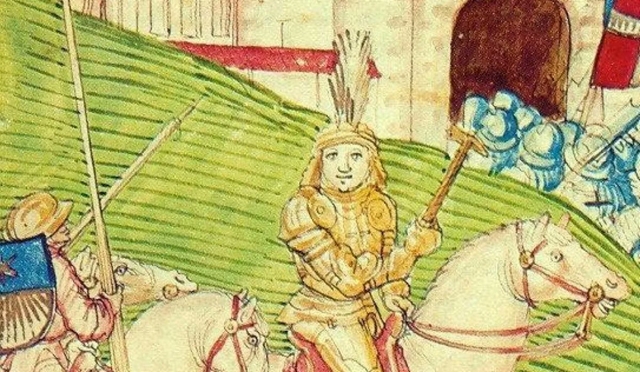Based on historical literature, it is known that in 1466 Adrian von Bubenberg, a famous Swiss Knight, visited Jerusalem as part of a pilgrimage to the Holy Land. Hundreds of years later these written historical testimonies were brought to life. As part of a study conducted by the archaeologist Michael Chernin and the photographer, Shai Halevi in the David's Tomb complex examining inscriptions of pilgrims, Adrian Von Bubenberg’s name and family symbol were unexpectedly discovered on one of the walls.
A graffiti inscription mentioning one of Switzerland's revered heroes, the knight Adrian von Bubenberg, was unexpectedly discovered during an archaeological survey conducted on Mount Zion. The results of the survey were published as part of the "Innovations in the Archeology of Jerusalem and its Surroundings" conference happening this week and is funded by the Israel Antiquities Authority, the Hebrew University of Jerusalem, and Tel Aviv University.
Over the past few months, the Jerusalem Region of the Antiquities Authority led a unique project in the David's Tomb complex on Mount Zion which focused on documenting the graffiti inscriptions and ancient inscriptions left by the Christian and Muslim pilgrims on the walls of the complex. More than 40 inscriptions in different languages were discovered, alongside symbols of knights from the Middle Ages.
A graffiti inscription commemorating one of Switzerland's revered heroes - the knight Adrian von Bubenberg, was unexpectedly discovered during an archaeological survey conducted on Mount Zion. pic.twitter.com/AFVEsUzWSd
— Dr. Haim Cohen دكتور حاييم كوهين (@Haim44) October 22, 2022
Deciphering the hidden texts was made possible through advanced documentation technologies developed by the Antiquities Authority as part of the study of the Qumran scrolls from the Judean Desert. These techniques use multispectral photography, among other things. The use of different wavelengths, in the visible and invisible field, brings back to the surface inscriptions that have been faded, eroded, and erased over the years.
Adrian von Bubenberg, Bern pic.twitter.com/vp5oZc7iYu
— J (@giellepi) June 20, 2019
"During the Mamluk period, between the years 1332-1551, the complex of buildings near the traditional tomb of King David was in the possession of the monks of the Franciscan Catholic order," said the directors of the research, Michael Chernin and Shay Halevi. "The place was used as a monastery and a hostel for pilgrims from Western Europe, and many left their mark on the walls. Today, after hundreds of years, the technologies have matured so that these inscriptions can be recognized and read again."
Have researchers in the City of David found the graffiti of 15th century Swiss Knight and national hero, Adrian von Bubenberg?#Jerusalem #medieval #graffiti https://t.co/VQAs0t1xzs pic.twitter.com/gdanm8Frni
— Ancient Origins (@ancientorigins) October 21, 2022
Among the abundance of inscriptions and graffiti found at the site, the researchers were amazed to also discover a charcoal inscription bearing the full name and family crest of Adrian von Bubenberg. Von Bubenberg was a Swiss Knight and statesman from the 15th century and is considered a revered national hero to this day in Switzerland. He was born in 1424 to a noble family. After serving several times as the mayor of Bern, Bubenberg gained his fame in 1476, when the army of the Swiss Alliance under his leadership defeated the army of Charles "the bold" - Duke of Burgundy, who threatened the independence of Switzerland, in a fateful battle.
The knight Adrian von Bubenberg is believed to have visited the holy city in 1466.https://t.co/KDhxtfEnUD
— ET Panache (@ETPanache) October 21, 2022
According to Eli Escocido, Director of the Antiquities Authority: "Research in Jerusalem is worldwide. Different religions, different cultures, believers and visitors from all over the world, sought to touch the Holy Jerusalem. They left here evidence and signs that the archaeologists and researchers of the Antiquities Authority discover and document every day. All of these, Joining and forming into a fascinating picture, of which we were given a small taste today."


